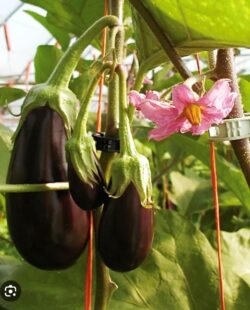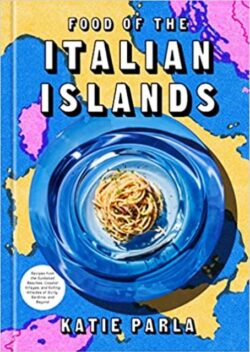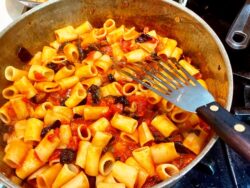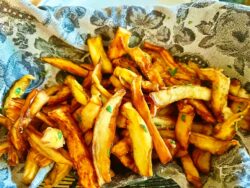Read Time: 4 Minutes Subscribe & Share
A Vegetable of Many Names
No one makes jokes about the abundance of eggplants the way zucchini gets mauled with memes and pranks. Its origins are in China and it owes its introduction to the West to Spanish explorers in the 16th century. Eggplant is called aubergine in France as well as in Germany. Even the British shamelessly copied the name from their competition across the Channel, as they have with the vegetable courgette, which we call zucchini (plural of zucchino – only in Italy it is a zucchina with a plural of zucchine). The Italians and the Spanish feel no allegiance to the word aubergine from their French neighbors and insist on calling it melanzana (Italy) or berenjena (Spain). And a little research tells us that when the first examples arrived in the US, the resulting vegetables were indeed egg-shaped and in some instances white; hence the term eggplant was adopted. Eggplants were viewed with suspicion as they, like tomatoes and potatoes, are members of the Nightshade family. But now, as we have literally piles of them at our farmers markets, I thought I would share two of my current favorite recipes.
pranks. Its origins are in China and it owes its introduction to the West to Spanish explorers in the 16th century. Eggplant is called aubergine in France as well as in Germany. Even the British shamelessly copied the name from their competition across the Channel, as they have with the vegetable courgette, which we call zucchini (plural of zucchino – only in Italy it is a zucchina with a plural of zucchine). The Italians and the Spanish feel no allegiance to the word aubergine from their French neighbors and insist on calling it melanzana (Italy) or berenjena (Spain). And a little research tells us that when the first examples arrived in the US, the resulting vegetables were indeed egg-shaped and in some instances white; hence the term eggplant was adopted. Eggplants were viewed with suspicion as they, like tomatoes and potatoes, are members of the Nightshade family. But now, as we have literally piles of them at our farmers markets, I thought I would share two of my current favorite recipes.
The Pure Goddess of Pasta
 One is from Katie Parla’s new cookbook, from which I shared her delish puff pastry recipe for Cipolline Catanesi. I had tried making Pasta Alla Norma, which has its roots also in Catania, from another video and an earlier cookbook. But the recipes had too many components and both tries turned out a bit stodgy, like my initial trial with Spaghetti alla Carbonara. But Katie Parla’s version is terrific and easy, with the four sacred ingredients – eggplant, tomatoes, basil and ricotta salata (not counting some garlic and extra virgin olive oil). Legend has it that its name is a reference to the perfection of Vincenzo Belllini’s opera “Norma,” uttered by the writer Nino Martoglio when he first tasted it at the home of Signora Saridda:
One is from Katie Parla’s new cookbook, from which I shared her delish puff pastry recipe for Cipolline Catanesi. I had tried making Pasta Alla Norma, which has its roots also in Catania, from another video and an earlier cookbook. But the recipes had too many components and both tries turned out a bit stodgy, like my initial trial with Spaghetti alla Carbonara. But Katie Parla’s version is terrific and easy, with the four sacred ingredients – eggplant, tomatoes, basil and ricotta salata (not counting some garlic and extra virgin olive oil). Legend has it that its name is a reference to the perfection of Vincenzo Belllini’s opera “Norma,” uttered by the writer Nino Martoglio when he first tasted it at the home of Signora Saridda:
Chista e’ ‘na vera Norma, – This is a true Norma
If you have the skinny elongated eggplants, slicing them thinly like a cucumber but unpeeled, makes a nice presentation. But with the larger eggplants, Katie Parla’s recipe calls for unpeeled ones cut into small cubes. Sauteing them correctly in extra virgin olive oil, makes quite a difference. Do not skip over the step of checking the temperature of your frying oil. You don’t want it to dip into the low 300F (150C) range or over the 360F(180C) frying range. You want the cubes to be be lightly browned with golden touches, not dark brown. And you don’t want the oil so low that the eggplant absorbs oil before getting a bit crispy and she advises you to only wipe out the pan before the next step. Her advice to crush the tomatoes by hand does indeed give you a nifty texture to the sauce. different then if you had roughly chopped them with a knife. You can listen to Casta Diva as sung by Maria Callas or Renee Fleming while you make this simple but sublime dish.
nice presentation. But with the larger eggplants, Katie Parla’s recipe calls for unpeeled ones cut into small cubes. Sauteing them correctly in extra virgin olive oil, makes quite a difference. Do not skip over the step of checking the temperature of your frying oil. You don’t want it to dip into the low 300F (150C) range or over the 360F(180C) frying range. You want the cubes to be be lightly browned with golden touches, not dark brown. And you don’t want the oil so low that the eggplant absorbs oil before getting a bit crispy and she advises you to only wipe out the pan before the next step. Her advice to crush the tomatoes by hand does indeed give you a nifty texture to the sauce. different then if you had roughly chopped them with a knife. You can listen to Casta Diva as sung by Maria Callas or Renee Fleming while you make this simple but sublime dish.


- 2lbs eggplant, (just under a kg) - about 2 medium globes - cut into 3/4 inch cubes
- Sea salt
- 1 garlic clove smashed and peeled
- At least 3/4 cups (178ml) olive oil
- 6 fresh basil leaves, plus a few leaves for garnishing each person's plate
- 14.5 ounce can (411gr) whole peeled tomatoes, crushed by hand
- 1 (454gr) paccheri or rigatoni
- 3 ounces (85gr) ricotta salata, coarsely grated
- Place the eggplant in a colander and sprinkle all over with abundant salt to draw out all the water.
- Set aside to drain for an hour and then rinse and dry with paper towels.
- Fill a 10 to 12 inch (25-30cm) frying pan or cast iron skillet with 1//2 cup of the olive oil and heat the oil over medium high heat to 375F (190C)
- Regulate the heat at 350F (177C)as you fry.
- Working in batches so as not to crowd the pan, fry the eggplant, turning to ensure even browning
- until deep golden brown, about 10 minutes.
- Add more oil as needed, then drain on paper towels and set aside.
- Discard any remaining oil and wipe the pan clean.
- Heat the remaining 1/4 cup (120ml) of olive oil in the same pan over medium low heat.
- When the oil begins to shimmer, add the garlic and cook until it just starts to take color - about 3 minutes.
- Add the basil, cooking until fragrant, 30 seconds, then add the tomatoes and season with salt.
- Cook until the tomatoes have lost their raw flavor, about 10 minutes.
- Stir in the eggplant and cook for 1 minute more.
- Meanwhile, bring a large pot of water to a rolling boil over high heat.
- Salt the water - until it tastes like a seasoned soup.
- Add the paccheri or rigatoni and cook until "al dente".
- Drain the pasta, reserving the cooking water.
- Add the pasta to the sauce and stir to coat.
- Add a bit more of the pasta cooking water to loosen the sauce as needed.
- Plate and serve with some of the ricotta salata on top and basil to garnish.
 dry it. Peel the eggplant and the cut into 1/4 inch (.65cm) slices, then into “french fry” strips. I wrap them in a towel to absorb some moisture. For 2 to 3 eggplants, a cup of all purpose flour is plenty. Salt the flour and add either 1/2 to 1 teaspoon thyme or cumin to the flour. A few grinds of fresh pepper is nice too. Heat your oil – I use a base of sunflower seed oil mixed with some generic olive oil, or duck fat. Dredge your eggplant strips in batches and shake them in a strainer or colander, to get rid of the excess flour. Once your oil hits 360F (180C) , you are ready to fry your eggplant strips. Each batch should just take a couple of minutes, turning them over in the hot oil until they are a deep gold color. Allow them to drain some of the oil on either a clean cloth towel or paper towels, but serve immediately. Sometimes I will sprinkle some finely chopped summer herbs into the fries. Any yoghurt based dip makes an unusual cool sauce to go with these irresistible fries.
dry it. Peel the eggplant and the cut into 1/4 inch (.65cm) slices, then into “french fry” strips. I wrap them in a towel to absorb some moisture. For 2 to 3 eggplants, a cup of all purpose flour is plenty. Salt the flour and add either 1/2 to 1 teaspoon thyme or cumin to the flour. A few grinds of fresh pepper is nice too. Heat your oil – I use a base of sunflower seed oil mixed with some generic olive oil, or duck fat. Dredge your eggplant strips in batches and shake them in a strainer or colander, to get rid of the excess flour. Once your oil hits 360F (180C) , you are ready to fry your eggplant strips. Each batch should just take a couple of minutes, turning them over in the hot oil until they are a deep gold color. Allow them to drain some of the oil on either a clean cloth towel or paper towels, but serve immediately. Sometimes I will sprinkle some finely chopped summer herbs into the fries. Any yoghurt based dip makes an unusual cool sauce to go with these irresistible fries.

After owning one of the best cooking stores in the US for 47 years, Nancy Pollard writes a blog about food in all its aspects – recipes, film, books, travel, superior sources and food related issues.



